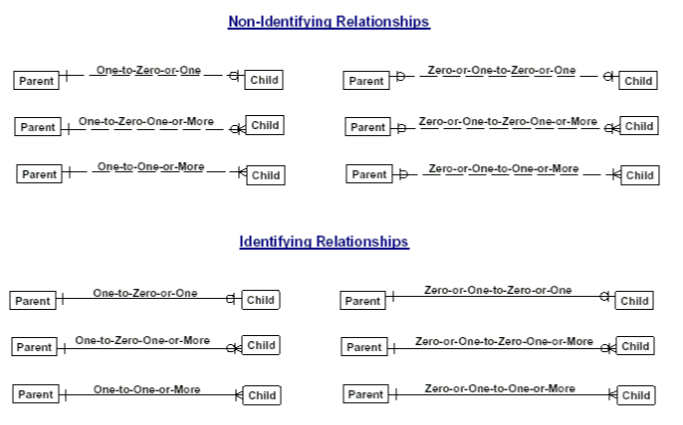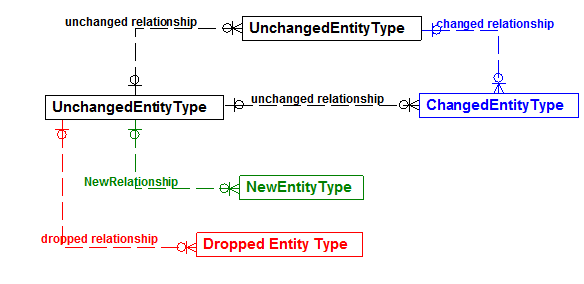Diagram Notation
The ARTS Operational Data Model uses the Information Engineering (IE) methodology and notation scheme for representing its data structures. The IE methodology uses a standard set of symbols and notations to represent entity types, relationships, attributes, subtypes as illustrated below.
Figure 3 - Entity Relationship Cardinality

The ARTS Operational Data Model can be decomposed into a number of high-level views. A data model view is a subset of the retail store data model.
•Primary Key explains in business terms how entity instances are identified and distinguished from each other;
•Foreign Key is an occurrence of one entity's primary key in another entity or the same entity. It results from the migration of the primary key from one entity to the other entity through a specific relationship;
•Identifying whereby an instance of the child entity is identified through its association with the parent entity. The primary key attributes of the parent become the primary key attributes of the child. These are represented in the data model as solid lines with a dot; and
•Non-identifying whereby an instance of the child entity is not identified through its association with the parent entity. The primary key attributes of the parent become the non-key attributes of the child. In the ERWIN version of the model, these are represented in the data model as dashed lines.
Relationships have properties, referred to as cardinality. Cardinality defines how many of each related entity may or must participate. This cardinality is represented in the data model by a relationship symbol near where the relationship attaches to the child and parent entities. Figure 3 presents the various possibilities:
From the retailer perspective, entities provide a way to organize and store the data needed to run a retail enterprise. Data in and of itself is a limited a resource for managing a retail enterprise. However, the data becomes meaningful when mapped out according to relationships, organization, and governance system of the business itself. This additional context transforms random bits of information into a meaningful store information model
When data is put into a business context that shows how it is organized and related - and makes the business rules governing its organization and relationships explicit, it becomes business information. The explicit representation of these business rules and definitions adds meaning to the retail store data - and that meaning transforms random bits of data into a meaningful store information model.
In addition to the IE notation, the ARTS Operational Data Model diagrams use color to highlight new entities and relationships that have been added in release 7.3 and entities and relationships in version 7.0 that have been changed. Readers who are familiar with release 7.2 should carefully review the additions and changes in version 7.3. The entity diagram below illustrates the color scheme used in ARTS IE Entity Relationship Diagrams.
Figure 4 - Entity Modeling Color Coding Key

Version 7.3 of the ARTS Operational Data Model builds on the retail enterprise orientation of Release 7.2. Though originally designed as a store-oriented model, the ARTS Operational Data Model since Release 4 has grown into a retail enterprise model.
Narrative Formatting
The narrative uses the following fonts to highlight specific data model object names and references:
•Entity names and Attribute names are presented as EntityName and AttributeName. Per ARTS standards, names use a camel case format without spaces.